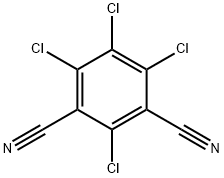Chlorothalonil

|
- ₹7631.63 - ₹8300
- Product name: Chlorothalonil
- CAS: 1897-45-6
- MF: C8Cl4N2
- MW: 265.91
- EINECS:217-588-1
- MDL Number:MFCD00045594
- Synonyms:tetrachloro-meta-phthalo-dinitrile ;Tetrachloro-m-phthalodinitrile;Tpn (pesticide);tpn(pesticide) ;Tripart faber;Tripart ultrafaber;Tuffcide;Vanox
2 prices
Selected condition:
Brand
- TCI Chemicals (India)
- Sigma-Aldrich(India)
Package
- 250MG
- 25G
- ManufacturerTCI Chemicals (India)
- Product numberT0895
- Product descriptionTetrachloroisophthalonitrile min. 98.0 %
- Packaging25G
- Price₹8300
- Updated2022-05-26
- Buy
- ManufacturerSigma-Aldrich(India)
- Product number36791
- Product descriptionChlorothalonil PESTANAL?, analytical standard
- Packaging250MG
- Price₹7631.63
- Updated2022-06-14
- Buy
| Manufacturer | Product number | Product description | Packaging | Price | Updated | Buy |
|---|---|---|---|---|---|---|
| TCI Chemicals (India) | T0895 | Tetrachloroisophthalonitrile min. 98.0 % | 25G | ₹8300 | 2022-05-26 | Buy |
| Sigma-Aldrich(India) | 36791 | Chlorothalonil PESTANAL?, analytical standard | 250MG | ₹7631.63 | 2022-06-14 | Buy |
Properties
Melting point :250-251°
Boiling point :bp760 350°
Density :d425 1.7
vapor pressure :7.6 x 10-5 Pa (25 °C)
Flash point :2 °C
storage temp. :0-6°C
solubility :180mg/L in organic solvents at 20 ℃
Water Solubility :0.6-1.2 mg l-1 (25 °C)
form :Powder
color :White
Odor :odorless in pure form
Merck :14,2166
BRN :1978326
Exposure limits :An experimental carcinogen.
Stability :Light Sensitive
InChIKey :CRQQGFGUEAVUIL-UHFFFAOYSA-N
LogP :2.94 at 25℃
CAS DataBase Reference :1897-45-6(CAS DataBase Reference)
IARC :2B (Vol. Sup 7, 73) 1999
NIST Chemistry Reference :Tetrachloroisophthalonitrile(1897-45-6)
EPA Substance Registry System :Chlorothalonil (1897-45-6)
Boiling point :bp760 350°
Density :d425 1.7
vapor pressure :7.6 x 10-5 Pa (25 °C)
Flash point :2 °C
storage temp. :0-6°C
solubility :180mg/L in organic solvents at 20 ℃
Water Solubility :0.6-1.2 mg l-1 (25 °C)
form :Powder
color :White
Odor :odorless in pure form
Merck :14,2166
BRN :1978326
Exposure limits :An experimental carcinogen.
Stability :Light Sensitive
InChIKey :CRQQGFGUEAVUIL-UHFFFAOYSA-N
LogP :2.94 at 25℃
CAS DataBase Reference :1897-45-6(CAS DataBase Reference)
IARC :2B (Vol. Sup 7, 73) 1999
NIST Chemistry Reference :Tetrachloroisophthalonitrile(1897-45-6)
EPA Substance Registry System :Chlorothalonil (1897-45-6)
Safety Information
| Symbol(GHS): |
   
|
|||||||||||||||||||||||||||||||||||||||||||||||||
|---|---|---|---|---|---|---|---|---|---|---|---|---|---|---|---|---|---|---|---|---|---|---|---|---|---|---|---|---|---|---|---|---|---|---|---|---|---|---|---|---|---|---|---|---|---|---|---|---|---|---|
| Signal word: | Danger | |||||||||||||||||||||||||||||||||||||||||||||||||
| Hazard statements: |
|
|||||||||||||||||||||||||||||||||||||||||||||||||
| Precautionary statements: |
|
Description
Chlorothalonil is a broad-spectrum organic fungicide mainly used to control fungi that threatens a number of agricultural crops, vegetables, trees, fruits, turf and paints, etc. It can also serves as a wood protectant, pesticide, acaricide, which is effective to kill mildew, bacteria, algae, and insects. Besides, it can commercially act as a preservative additive in several paints, resins, emulsions, coatings and can be used on commercial grasses such as golf courses and lawns.Chlorothalonil was first registered by the EPA in 1966. It is environmentally persistent and binds strongly with soil, whose expected half-life in aerobic soils is one to three months. Chlorothalonil functions by reducing the intracellular glutathione molecules of fungal to alternate its forms which affects the essential enzymatic reactions of fungal, ultimately leading to cell death.
More related product prices
Phthalic anhydride 1,4-Dicyanobenzene 2377-81-3 Tetrachlorophthalic anhydride Tetrachlorophthalic acid 1,3-Dicyanobenzene 4-Aminophthalonitrile O-Phthalimide Phthalonitrile Dibutyl phthalate Hymexazol Thiophanate-methyl 2,5-Dichlorobenzonitrile 2-Chlorobenzonitrile 2,3-Dichlorotoluene 2,6-Dichlorobenzonitrile 1953-99-7 4-Chlorobenzonitrile 4-CHLORO-M-XYLENE 2,4-DichlorobenzonitrileRelated product price
- Phthalic anhydride
₹430-55330 - 1,4-Dicyanobenzene
₹1948.5-21400 - 2377-81-3
₹6800-21300






